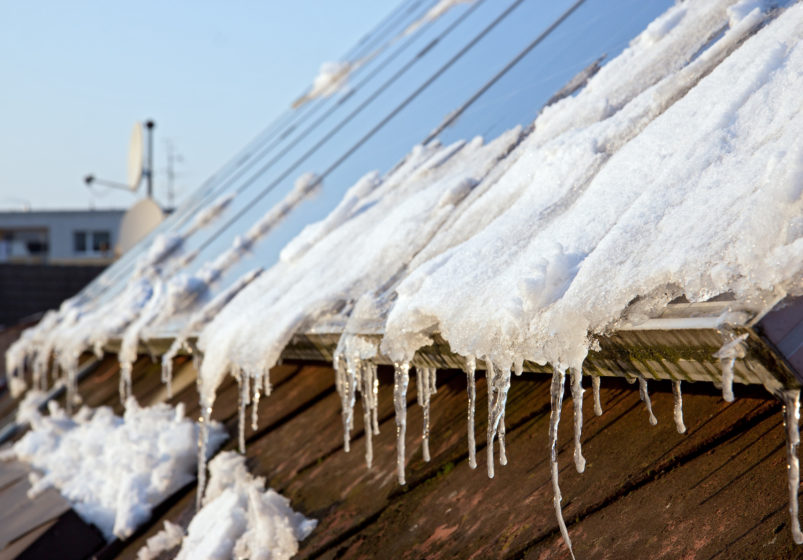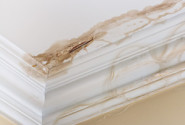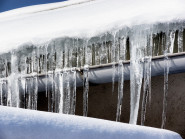
Ah… the Canadian Winter…
So far it’s been a roller coaster ride when it comes to our weather this winter. First warm and sunny, then a little snow, then lots of snow, then windy & cold, freezing cold, and then bone-chilling, don’t wanna go outside cold! The kind of cold where your breath freezes in the air. And sadly, we received lots of calls for frozen and burst pipes that kept us busy. What will Mother Nature throw at us next? Rain, of course! Just enough to quickly melt the snow and refreeze the next day, making our lives miserable and travel treacherous.
With the constant changes in temperature, our plumbing systems are challenged. Pipes and valves can freeze then thaw and burst, flooding your home. Sump pumps and septics are vulnerable too. So what can you do? Well, the best you can. Here are a few tips to protect your plumbing and your home this winter:
-
Protect Your Pipes
Unfortunately, some piping is located against an exterior wall or in unheated/low heat areas such as in the garage, porch, crawl space, attic or basement. Protect these vulnerable pipes by wrapping them in heat tape and/or foam rubber pipe insulation. If you’re turning the heat tape/coil on again from previous years, confirm it is working. Spray foam or add insulation to any holes where a draft is coming in and between the wall and the pipe. Close your garage door after using to prevent that frigid wind from entering.
During those days with Arctic-like temperatures, turn on both the hot and cold on faucets of susceptible pipes and let the water gently trickle to prevent pipes from freezing. Open cabinet doors to allow heat in around those pipes. If it’s a particularly cold area, place portable heaters nearby in the room to decrease the chance of your pipes freezing. And don’t forget to turn up the thermostat – a few extra dollars spent for a short time could save you thousands in damages should the pipes freeze and burst.
2. Stop Water Damage
 When the water in your plumbing pipes freezes, it expands. Once it starts to warm up, the pipes may burst. Follow the tips above to prevent freezing. If they are already frozen, allow heat to get to them but never apply heat directly to a frozen pipe as it will burst. Make sure everyone in your home knows where the main shut off valve is and how to turn it off in case of an emergency. The quicker you shut off the water, the less water damage you’ll have in your home should a pipe burst. Be sure to test your shut off valve at least twice annually to make sure it works and get it repaired right away if it won’t turn off or it leaks. It’s also a good idea to let others, like relatives and babysitters, know where it is located and who to call should you be away.
When the water in your plumbing pipes freezes, it expands. Once it starts to warm up, the pipes may burst. Follow the tips above to prevent freezing. If they are already frozen, allow heat to get to them but never apply heat directly to a frozen pipe as it will burst. Make sure everyone in your home knows where the main shut off valve is and how to turn it off in case of an emergency. The quicker you shut off the water, the less water damage you’ll have in your home should a pipe burst. Be sure to test your shut off valve at least twice annually to make sure it works and get it repaired right away if it won’t turn off or it leaks. It’s also a good idea to let others, like relatives and babysitters, know where it is located and who to call should you be away.3. Check Pumps and Septic
Check your sump and sewage pumps and pits for debris and clean out pits. Regularly remove any leaves, snow or ice outside that could block the sump pump discharge pipe. Change a longer discharge pipe to a shorter one in winter which makes it less likely to freeze as it is closer to the house. Protect your discharge pipe from freezing with bags of leaves or straw over top, about a foot deep. Regularly test to see how well your sump pump is working by pouring a couple of buckets of water into the pit. Better to know now if there is a problem before you need to rely on it to work. If you have a battery back-up sump pump, test it as well. Change out an old battery for a new one (batteries are good for only about 2 years).
If you are on a septic, your lines can also freeze. Snow is the best insulator so when there is little snow, frost goes deep into the ground. If the soil over your septic lines isn’t deep enough, you’ll have to protect them from freezing. Like your sump pump discharge line, protect the pipe from your house to the tank with insulating material like straw, hay, bags of leaves etc. Do the same to the exit pipe from the tank to the drainfield. Also apply the same tips as above for protecting your pipes inside. Check the baffles/filters regularly and clear any debris from them. If you have a special aeration-type system, get your septic serviced before the frigid weather to prevent back-ups at the worst time. And don’t drive any vehicles over any part of your septic system because compacted snow will not insulate as well as untouched snow.
4. Clear Eaves-troughs and Downspouts
 Remove debris from your eavestroughs, gutters and downspouts. Water that can’t drain away can pool around your home’s foundation and eventually find a way inside. Water trapped in eavestroughs can build up under shingles, freeze, expand and lift up your shingles. Once it starts to thaw from the heat in your home or a sunny day, the melting water can find its way down through your ceiling and walls causing damage. Many people call their plumber believing it to be a plumbing problem.
Remove debris from your eavestroughs, gutters and downspouts. Water that can’t drain away can pool around your home’s foundation and eventually find a way inside. Water trapped in eavestroughs can build up under shingles, freeze, expand and lift up your shingles. Once it starts to thaw from the heat in your home or a sunny day, the melting water can find its way down through your ceiling and walls causing damage. Many people call their plumber believing it to be a plumbing problem.
If you need help with your home’s plumbing, septic, well or pumps, give us a call at 1-888-458-1979.